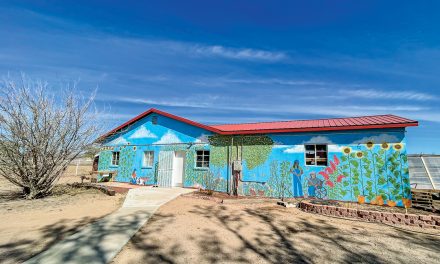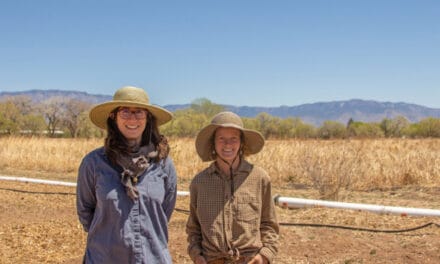Understanding the Realities of
New Mexico’s Farmworkers
By Anita Ashok Adalja

Photo by Stephanie Cameron.
If you have purchased food at a farmers market or a grocery like La Montañita Co-op, or subscribed to a community supported agriculture (CSA) program, you can be sure that some, if not all, of your produce has been grown and handled by a farmworker. More often than not, the work of farm laborers is unsung, unrecognized by the public, and at times unacknowledged by even the farm operators. Almost certainly, they are not the face of the farm.
This hidden facet of farms leads us to lean on stereotypes to understand the complexities of who America’s farmworkers are. Our minds may fill with media images of migrant laborers working on large-scale commercial farms in California or Florida, moving from farm to farm, following the harvests. While this is still true for many who harvest our produce, the reality of the farm labor force has shifted over the past twenty years. More than 80 percent of the two to three million farmworkers in the United States are considered settled, meaning that they work and live within seventy-five miles of a single farm operation, rather than shuttling from farm to farm. Moreover, more than 54 percent are US citizens.
Contrary to popular imagery, labor on farms is not limited to large-scale farms; even smaller farms (one to fifteen acres) employ farm labor either as employees or as interns or apprentices who are paid a monthly stipend. These individuals range from H-2A workers to career farmworkers to people pursuing first-time, hands-on experience in farming. No longer relying solely on word of mouth, farms can now advertise both seasonal and managerial positions through online resources including the Comfoods Jobs listserv, Good Food Jobs, New Mexico Landlink, Attra, and Craigslist. While it’s true that New Mexico small farms do not offer as many positions for seasonal farmworkers as more populated or well-resourced states like Virginia or California, as someone who has worked on three different farming operations in New Mexico, I can attest that these opportunities do exist, and though farmers markets customers may not see us, we are working behind the scenes.
The invisibility of farmworkers contributes to the devastating experiences of abuse and hardships endured by those responsible for our nourishment. Farmworkers are among the poorest workers in the United States: 25 percent earn wages below the federal poverty line, and a recent report from the Department of Labor found that the average annual income is $15,000 to $17,499 for a single farmworker and $20,000 to $24,999 for a family. Beyond low wages, farmworkers experience great physical tolls, including exposure to pesticides and heat stress, as well as boundless emotional hardships. According to a study by the National Center for Farmworker Health, over 30 percent of female farmworkers interviewed in North Carolina experienced significant symptoms of depression, and another study has found that 80 percent of female farmworkers in California have experienced on-the-job sexual harassment.
How do these widespread challenges compare to those of farmworkers working on small, local farms here in New Mexico? While these issues manifest more intensely on larger-scale farms or in an immigrant labor force, it’s important to understand they are systemic and impact all people working on farms that they do not own, including workers here at our go-to local farms.
For an industry that quite literally depends on the physical health and stamina of its employees, it is rare for a farm job to offer health care or wellness benefits. Twenty-five percent or more of farmworkers utilize subsidized community care clinics, and some are eligible for Medicaid or larger health care subsidies through the Affordable Care Act. A farmworker in Albuquerque, who wishes to remain anonymous, shared their experiences with health care benefits: “After four years of working on one farm, I got a $1,000 stipend for health insurance for the year. It didn’t cover all of my health insurance, but it offset most of it. That’s the most I’ve ever gotten.” Another farmworker told me, “I’ve never had any kind of health care through farming. I’ve been fortunate to not have to take advantage of workers’ comp.”
In addition to extremely limited health care benefits, farm work as an industry embraces a blood-sweat-and-tears mentality. With this mentality comes an expectation that workers will prevail through physical hardships or even injury. A female laborer, who has worked at several different farming operations in New Mexico, described the physicality of farming: “The time that I spent farming has definitely put a toll on my body. I think my back is forever messed up. I think one of the things with farming is always feeling like you have to push yourself for various reasons, meeting deadlines, trying to beat a frost, and harvesting as fast as you can.” Because of the constant and consistent workload that farming offers—each day, hour, and minute brings a new harvest, new challenge, new task—workers are often pressured, either by their supervisors or through peer pressure, to continue showing up to work, despite injury. This woman suffered a serious injury on a farm, had to pay for her own treatment, and continued working through her recovery. As she explained, “I did something to my back while farming. It got to a point where my entire left leg all the way down to my foot was numb. I couldn’t feel anything. It was really hard to walk. I found a chiropractor who would work with me on a sliding scale. . . . but I had to pay for everything out of pocket.” Reflecting on having worked through the injury, she added, “It was also one of those things—had I really had a conversation with someone [at the farm] about what was happening, they may have offered to compensate me in some way, but I never felt comfortable asking.”

Photo by Becky Scharff.
Some New Mexico farms do offer paid time off that can assist in preventing farmworkers from working through injury, but that benefit doesn’t address a culture of pushing through at all costs. One seasoned farmworker disclosed, “Two of the farms that I’ve worked at have had paid time off even when I was not a member of management. One of the farms that I worked at only had paid time off if you were part of management. Regardless of if we had paid time off, if you took the time off you were kind of looked down upon because you weren’t pulling your weight. I’m allergic to bees and I’ve gotten stung a few times. It’s a life-threatening reaction, but I’m always expected to come to work the next day. I’ve sliced my finger a few times and had to hand-transplant with pretty severe finger wounds.”
In addition to physical injury, farmworkers also experience compromised health and hygiene due to the lack of toilet access and handwashing stations in close proximity to the field. Because of large-scale, nationwide food safety outbreaks, the FDA has required farms of a certain size and income to comply with standards that require bathroom and handwashing availability for farmworkers. However, many small farms, which comprise the majority of farms in New Mexico, are not legally required to comply. Because of this loophole, many farmworkers have very precarious bathroom situations on the job. As one New Mexico farmworker described, these challenges are especially difficult for women: “As a female, your boss always tells you to feel free to go to the bathroom wherever it may be, but when the bathroom is five to ten minutes away and you’re running back and forth to the bathroom, it’s an issue. They pretend like it’s not [an issue] in the beginning, but then it becomes one. Having to explain to your male boss that it’s physically impossible to keep in a menstrual cup for that long—that’s a pretty embarrassing conversation to have.”
The challenge faced by farm operators in New Mexico is unique because oftentimes farms are made up of several smaller fields that may be separated by a couple miles, and it can be a financial hardship to outfit each field with a bathroom station. “Most of the farms I’ve worked at have been spread out across multiple sites and multiple fields. The bathroom situation at those farms has been less than ideal. There is usually only one actual bathroom with running water that you can use. Everywhere else, you have to find a secluded spot to pee or poop next to the field.” Even if the farm can afford multiple porta potties, they must be cleaned and maintained in order to provide a safe and realistic option for workers. As another worker explained, “We had a porta potty that was pretty close to the fields where we were working, but it wasn’t cleaned very often. The placement was in direct sun all day in the summer. It didn’t feel sanitary at all.”
Different power structures and isolation make farmworkers especially vulnerable and contribute to an extremely high rate of sexual harassment on farms. In 2010, the Southern Poverty Law Center interviewed 150 undocumented farmworkers, and 100 percent stated that sexual harassment was an issue on farms where they worked. This reality is not limited to undocumented farmworkers, nor large-scale farms. One New Mexico farmworker explained that while she hasn’t experienced it herself, she has witnessed nearly all of her female coworkers get sexually harassed. “At one farm, not only was the owner actively sexually harassing almost every femme employee, he also was sexist, so that was also an issue. Even though I wasn’t getting harassed, I was getting treated badly.” Another worker described the vulnerability she experiences working with a nearly all-male crew at a farm with no sexual harassment policy in place: “The farm owners set the tone of the farm, right? If they tolerate sexual harassment, or take part in it themselves, of course the rest of the crew is going to think it’s okay. It’s one thing if you’re telling a sexist or inappropriate joke, but it’s a domino effect, and then you find yourself alone in a field with your male coworkers who now think it’s okay to harass you and ask you to do sexually explicit things.”
One of the biggest challenges with confronting the different forms of abuse that happen on farms is that many of these businesses are small enough that the human resources department is literally the farm owners themselves. In a large office or more formal work setting, an employee might launch a complaint anonymously or to a third party, and oftentimes formal protections, such as a whistleblower policy, are in place to encourage open communication. On small farms, by contrast, farmworkers could very well risk their job by lodging a complaint. One farmworker in New Mexico explained: “It’s been hard when there are problems. You always have to find a diplomatic way to say whatever the problem is, even if it’s a huge issue, because with the farm owner, it’s always an ego thing. They always think you’re attacking what they have created even though it’s an issue happening on the farm and doesn’t necessarily have to do with them. . . . Rather than coming at it from a problem-solving approach, it’s like you’re blaming them instead of asking them for a solution.” This kind of response can lead to farmworkers downplaying the issue or ignoring it altogether. Another farmworker shared, “I feel like things just don’t get addressed. My experience has been a lot of niceties—saying things to keep the peace, but then ultimately not doing anything about it. It makes it extremely uncomfortable to have to bring up anything human-resources oriented because it’s always awkward.”
Food insecurity among farmworkers is also a harsh reality, with some studies showing that 66 percent of farmworkers are food insecure and do not have access to the very vegetables that they grow. Farmworkers interviewed in New Mexico for this article reported the wages they make or have made as $350 a week, $10 an hour, $13.50 an hour, and $15 an hour, and lower wages often prohibit farmworkers from enjoying the very fruits of their labor, unless the farm provides it to them as a benefit. One worker explained, “At least at the farm where I was able to get a CSA box, they offered us employee discounts for other stuff that they included in those boxes, so it was more affordable, but I definitely don’t think I would have been able to make it without having SNAP benefits.” Another farmworker described the irony of this reality for farmworkers: “At almost every farm that I’ve worked at, even as a member of management, I’ve been eligible [for SNAP], which is in itself a crazy statement. I grow this amazing, healthy food, but I can’t afford to buy it. I probably wouldn’t eat it if I wasn’t able to bring it home.” And even then, it’s not always a given that farmworkers are entitled to the produce that they grow.
Despite the significant hardships of working on farms, farmworker comradery prevails, and is often the reason people can emotionally labor through difficult situations on farms. In fact, a Gallup poll found that people who work with their best friends are seven times more likely to positively engage in their work than people who don’t work with close friends. Luckily on farms, the teamwork and shared experiences often create unbreakable bonds with fellow farmworkers. As one farmworker working primarily in Bernalillo County put it, “I’ve never really felt that supported by farm owners, but farm crews have always been super supportive of each other. If it hadn’t been for the support from my peers, encouragement, and taking care of each other, I would not have fallen in love with farming. Working with the crew has always made it so worthwhile for me.”
It can be a rude awakening to hear about the brutal challenges faced by farmworkers, near and far, on large- and small-scale operations, and by migrants, immigrants, and US citizens alike. Privilege and opportunity, however, do play a role in people’s different experiences. One worker described farming alongside migrant laborers in Corrales, and the difference in how they were treated: “They [the migrant laborers] were separated from the crew. For the most part, I feel like there was a very clear distinction between what they were expected to do versus what the rest of the farm crew was expected to do. It felt exploitative toward them. They would be expected to field-clean areas [such as pulling up drip tape and removing plastic mulch from the soil], pull weeds—more of the lower-skill tasks.” Another farmworker, while enduring abuse on farms, believes that the severity of her challenges do not compare to those of other farmworkers she has encountered: “Their struggle is definitely a lot harder than mine. They have a lot less rights and they get paid a lot less than I do. It’s not really an option for them like it is for me. I chose to be a farmer, and a lot of them didn’t necessarily choose to be migrant laborers. It’s how they can support their families. I think they need a lot more protection because they get used—people treat them like they are replaceable and they are not. We are not.”
To learn more about who is growing your food, you are encouraged to visit notourfarm.org and read the stories of farmworkers laboring across the United States and Canada. Not Our Farm is a nonprofit farmworker visibility and support project founded by the article’s author.
Edible celebrates New Mexico's food culture, season by season. We believe that knowing where our food comes from is a powerful thing. With our high-quality, aesthetically pleasing and informative publication, we inspire readers to support and celebrate the growers, producers, chefs, beverage and food artisans, and other food professionals in our community.












